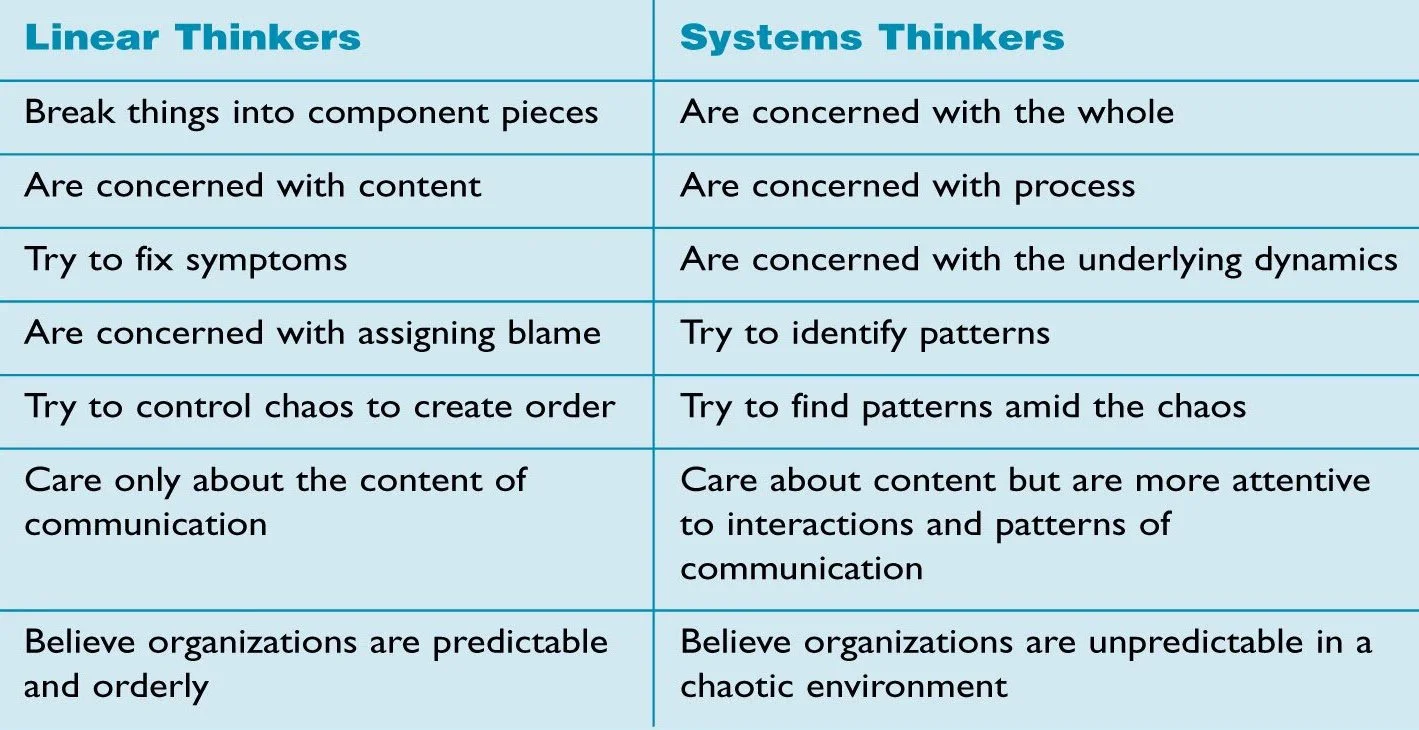A Brief Introduction to Systems Thinking
“What matters is not the isolated entity, but the space between things, the relationship of things – the Bond…Every conflict that occurs – whether between husband and wife, social or racial groups – is resolved only when we can fully see and embrace the space – the Bond – between us.”
Lynne McTaggart
Brief description
Talking about and working for systemic change, we first of all need to understand what we mean when we talk of systems. The following summary comes from the Fifth Discipline Fieldbook and gives a good first understanding:
“A system is a perceived whole whose elements “hang together” because they continually affect each other over time and operate toward a common purpose…. Examples of systems include biological organisms (including human bodies), the atmosphere, diseases, ecological niches, factories, chemical reactions, political entities, communities, industries, families, teams—and all organizations”.
Systemic thinking is “like a language for describing and understanding, the forces and interrelationships that shape the behaviour of systems” (see more here: Fifth Discipline Fieldbook). With this approach it is possible to get away from the - often only short-term effective - treatment of symptoms and to concentrate on the deeper causes, which are mostly inherent to a system (see also the chapter on Root Causes and the Iceberg Model).
Inner work
When we look at systems, the focus is therefore not on the individual bearer of a problem but on the entire system and its dynamics. When we dedicate our focus to support change in a system we, first of all, need to change our inner perception of the world - we have to start thinking systemic and in an interrelated way. Can I step into the perspective of someones else? Can I hold several perspectives at the same time and see how they correlate and inform each other? Can I see how one aspect of a system influences the others and is part of a dynamic, ever-moving whole?
This is important not only on an individual level but especially also important for the inner work of a team, organisation or even multistakeholder circle. Are we able to shift and dance - as Donella Meadows would say, with Systems?
Outer work
Turning to the external aspects of this work and with our care and attention to the ongoing inner work, we start to interact in the outer with a more aware attitude. Instead of making long-term plans and strategies that we then try to implement at all costs, we move with more care step by step, listen-act-listen-act. We take time to reflect and sense-make together and incorporate different signals and pieces of information into our actions and plans. We remind ourselves and each other that we are always just seeing one part of the system and therefore reach out beyond our comfort zone to others that may even have oppositional views. With curiosity, courage and compassion we lookout for common threads and aspects that we can build upon.
In the outer dimension of our work, we want to understand and identify where the challenges and predicaments appear in the particular system we want to help shift. This can happen through systems mapping, understanding the root causes and work with the iceberg model and being curious about how “our” system is correlating and entangled with other systems. This is not always a fun part of the work as it requires us to engage with the mud and the more messy parts of the system.
Once we have a clear understanding and sense of the system and its multilayeredness we can begin to see where there are leverage points - smaller or bigger ones - that could help shift the system to a new, and healthier place (see also the work of Donella Meadows on Places to intervene in a system). As part of the work with the iceberg model, we also reflect together about the aspired reality and map out the preconditions that would allow that.
Interplay
There is much to be shared, written and especially explored when we enter the space between the inner and outer work. Working from a systemic thinking (and being) perspective is a constant dance between our ways of thinking and meaning-making, and how that informs our actions and behaviours and vice-versa. This graphic gives a good starting point:
Thinking in systems and interrelated ways is not something that we have to learn up and study from books. It's actually a rather playful way of unlearning the more siloed and isolated ways of thinking most of us got conditions by. It's an invitation to perceiving the world around us anew, and immersing ourselves again in ways of being that are also role modelled by nature and practised by indigenous ways of living. Once we lean into it more, connections, webs of interconnectedness and correlations start to appear, and deeper care for especially also the fringes of a system become more central. Enjoy this never-ending exploration.
List of connected topics
Leadership
The How of Systemic Change
Complexity
Sense-Making
Leverage Points
Further references
Luea Ritter has been part of the design and hosting team for a previous Catalyst Lab at collaboratio helvetica. Luea is now part of the Practitioner Circle and supports different long-term mandates. She thrives within complexity, and through a diverse medley of fields she has developed a high sensitivity for context-based social dynamics. She weaves societal and systemic change practices, trauma and healing work, leadership, collaboration and earth-based wisdom traditions to cultivate capacities in individuals and collectives. Besides her work for collaboratio helvetica she works internationally across sectors to guide multi-stakeholder design and transition processes that embrace the challenge and potential of our times and support social innovation. She co-founded Collective Transitions, an action-research organization dedicated to making the implicit valued, and building shared capacities for transformational shifts.


